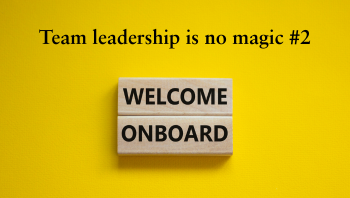Team Leadership is no magic - Part 2: 4 ideas for onboarding processes
How new team members not only arrive, but get off to a flying start!
Do you remember your first day in a new team? It was probably a bit like the first day at school: lots of new faces, unfamiliar rituals and the quiet fear of doing something wrong. Where do I actually have to go? Who are the cool people you want to get on with? And what the heck are everyone's names again?
New team members often experience sensory overload. It's a cognitive obstacle course between expectations, information and unspoken team rules. Poor onboarding could therefore be compared to a book without a table of contents: you flip through the pages aimlessly, hoping to find the most important information by chance at some point.
Good onboarding, in contrast, should feel like an exciting journey with a clear roadmap.
All aboard – here's what four elements of the onboarding process might look like:
1. A team logbook: Your map through the information jungle
Imagine you're boarding a moving train. The landscape rushes by, the conversations around you only make sense halfway, and an important decision lurks somewhere on the horizon. That's often what onboarding feels like.
To prevent newcomers from feeling lost, they need a clear overview of what has happened so far. This is where the team logbook comes in: a central place where important discussions, decisions and the famous “aha moments” are collected.
Not as endless unedited minutes, but as condensed knowledge bites: with pictures, videos/audios or short summaries. More Instagram than Excel spreadsheet! And no, you don't need an internal graphics or communications department for that:
modern tools like ChatGPT or Copilot help to automatically structure meetings and filter out the essentials. This way, new colleagues know immediately:
- What has the team achieved so far?
- What open questions are there?
- And above all: What is our contribution to the big picture/the departmental or corporate strategy?
2. Four questions every team member should be able to answer in their sleep
Every team is like a band: there's a common sound, but everyone has their own instrument. And if everyone just plays wildly, it quickly sounds like a mix of free jazz and a jackhammer. To help newcomers find the right rhythm right away, there are four simple but crucial questions:
🎯 What is our common goal? (What are we working towards?)
🎸 What is my individual contribution? (Which instrument do I play?)
🎼 What are the rules of the game? (How do we resolve conflicts and make decisions?)
🧐 What is expected of me – and what can I expect of others?
If you can answer these questions, you not only understand your role in the team, but also how you can meaningfully contribute. Because one thing is clear: nobody wants to be the triangle in the orchestra – well-intentioned but barely audible.
3. The “Holy Role Clarification” 😉 – or why clarity is everything
In many teams, the distribution of roles is a kind of tacit consensus. Sometimes practiced over years. But the problem with unspoken expectations is that sooner or later they lead to misunderstandings.
That's why the onboarding routine includes the “holy role clarification” – preferably right at the beginning. There are three key points:
- What exactly are my tasks?
- Where is my scope for decision-making?
- What responsibilities do I have – and what are my limits?
Clarity in these areas prevents newcomers from wandering around in the gray areas between “too much initiative” and “too little independence”. After all, no one can perform when their expectations are unclear. Incidentally, the concept of a “professional role” is highly recommended for collaboration and the further development of individuals and teams. So it's definitely worth taking a look :-) We've linked a good resource below this article.
4. Regular check-ins: Because everything is constantly changing
Onboarding is not a one-time event, but a dynamic process. Expectations are often so complex that a one-time exchange is not enough. Team structures and projects change, etc. Someone who “knows the store” will probably find it easier. However, this also means that the role of new colleagues is gradually changing. If this can be done with as little disruption as possible, it is important to schedule regular check-ins.
These should not just consist of a “So? Everything okay?” but should specifically address the following questions:
💡 Does the person feel confident in their role?
💡 Are there any uncertainties or obstacles?
💡 Have their expectations or responsibilities changed?
This helps keep the onboarding process fresh and ensures it doesn't become a forgotten to-do list that languishes somewhere between “pick up employee ID card” and “get password for printer”.
Conclusion: smart onboarding pays off
When new employees know from the start what's expected of them and how they can contribute, their motivation and productivity increase. A well-thought-out onboarding process is not just nice, but a real competitive factor for every company.
Let's be honest: nobody wants to be the new employee who feels invisible or insecure for weeks. And with the right onboarding, nobody has to stay in that role.
🚀 So: no more “learning by confusion” – and let's have a clear, motivating onboarding!
Call4Action:
Want to learn more about professional roles and team dynamics? Keep chatting with our specialized ToChange/OpenAI New Work GPT! 🚀


About me

All Rights Reserved
Get in touch
-
+49-(0)941 600 93 003
-
This email address is being protected from spambots. You need JavaScript enabled to view it. -
Thomas_Huber
ToChange Gmbh
-
Thomas Huber
-
Traubengasse 6
-
D-93059 Regensburg

